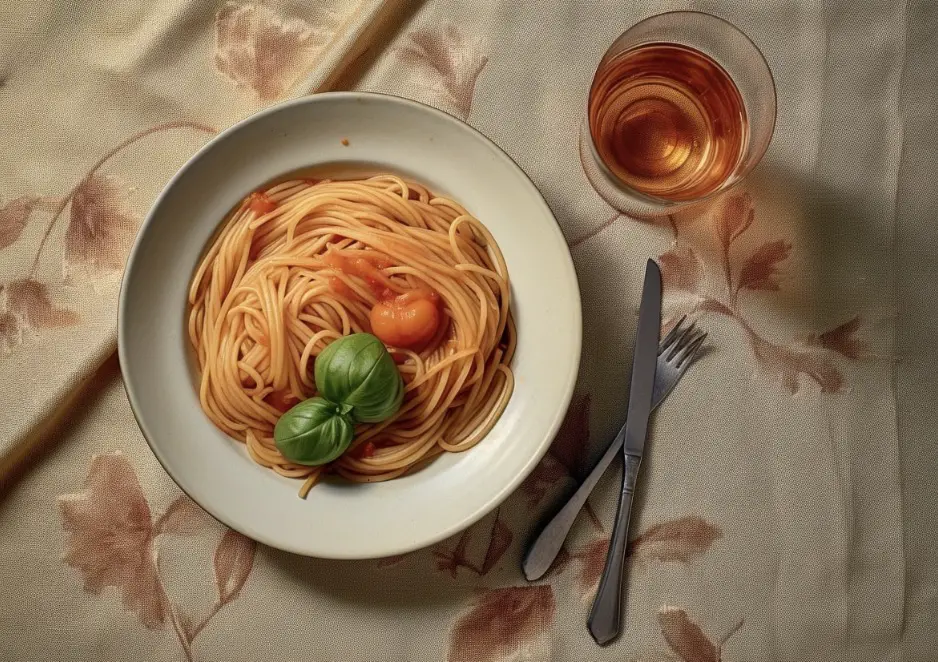In my personal experience, cider can go well with spaghetti or pasta when it’s the right pairing.
In this blog post, we will explore the various ways to enjoy cider with spaghetti or pasta, focusing on finding the perfect balance of flavors and textures to create a memorable meal.
A Brief History of Cider
Cider, a fermented alcoholic beverage made from apples, has a history that dates back thousands of years. It’s believed that the first ciders were produced in the region now known as Kazakhstan around 6500 BCE, where apples originally came from. The beverage then spread to Europe, where it became a popular drink among the Celts and Romans.
In recent years, cider has experienced a resurgence in popularity, particularly in the United States and the United Kingdom, where new cideries continue to open and experiment with unique flavor profiles and production techniques. With this renewed interest in the beverage, cider has found its way onto the dinner table as an accompaniment to various dishes, including pasta.
The Right Cider for Your Pasta Dish
When pairing cider with pasta, it’s crucial to consider the ingredients and flavors in the dish. Pasta comes in a variety of shapes, sizes, and flavors, with countless sauce options to choose from. The right cider can help to enhance these flavors and create a harmonious dining experience.

Tomato-Based Sauces
For pasta dishes featuring a tomato-based sauce, such as spaghetti marinara or penne arrabbiata, a crisp, dry cider with a hint of acidity is ideal. This type of cider will help to cut through the richness of the tomato sauce and refresh the palate between bites. A good example is a traditional English dry cider, which typically has a sharp, tart flavor that complements the acidity in tomato-based sauces.
Cream-Based Sauces
When it comes to pairing cider with pasta dishes featuring cream-based sauces, such as fettuccine alfredo or penne alla vodka, a sweeter, fruitier cider is recommended.
The sweetness of the cider will balance out the richness of the cream sauce, while fruity notes can add an extra layer of flavor that complements the dish. Look for a cider with a prominent apple flavor, like a New England-style cider or a French cidre doux.
Pesto and Herb Sauces
For pasta dishes with pesto or herb-based sauces, a light, crisp, and slightly sweet cider works best. The freshness of the cider will match the bright, herbaceous flavors in the sauce, creating a harmonious pairing. A semi-dry, unfiltered cider with a slight effervescence is an excellent choice for these types of dishes.
The Importance of Temperature and Serving
When serving cider with pasta, it’s important to consider the temperature of the beverage. Most ciders should be served chilled, but not ice cold. This allows the flavors and aromas of the cider to shine through without being masked by excessive chill. Aim for a serving temperature of around 45-50°F (7-10°C) for the best results.
It’s also worth noting that the glassware you choose can impact the overall experience of enjoying cider with pasta. A wine glass or a tulip-shaped glass is ideal, as it allows the cider to breathe and helps to release its aromas, enhancing the overall sensory experience.
The Role of Carbonation
One of the key characteristics of cider is its carbonation. The bubbles in cider can help to cleanse the palate between bites of pasta, making each mouthful feel fresh and new.
This is particularly important when enjoying a rich, flavorful pasta dish, as it prevents the flavors from becoming overpowering.
When choosing a cider to pair with pasta, consider the level of carbonation. A lightly sparkling cider will offer a refreshing lift without being too overpowering, while a still cider may lack the palate-cleansing effect. Highly carbonated ciders can also work well, but they may compete with the flavors of the pasta dish, so choose wisely.
Cooking with Cider
Another way to incorporate cider into your pasta experience is by cooking with it. Cider can be used as a cooking liquid, a deglazing agent, or as a component of a sauce. For example, you could use cider to deglaze a pan after sautéing onions and garlic for a tomato-based sauce, adding an extra layer of flavor and complexity to the dish.
When cooking with cider, choose a variety with flavors that will complement the other ingredients in the recipe. A dry, crisp cider works well for deglazing and reducing, while a sweeter, fruitier cider can add depth to a cream-based sauce.
Conclusion
In conclusion, cider can be a delightful accompaniment to spaghetti or pasta dishes when thoughtfully paired. To recap, here are 10 key points to consider when enjoying cider with pasta:
1. Consider the flavors and ingredients in the pasta dish when choosing a cider to pair with it.
2. For tomato-based sauces, opt for a crisp, dry cider with a hint of acidity.
3. Cream-based sauces work well with a sweeter, fruitier cider.
4. A light, crisp, and slightly sweet cider is ideal for pesto and herb-based sauces.
5. Serve cider at a temperature of around 45-50°F (7-10°C) for optimal flavor.
6. Use a wine glass or tulip-shaped glass to enhance the aroma and taste of the cider.
7. Consider the level of carbonation in the cider, as it can impact the overall pairing experience.
8. Cooking with cider can add depth and complexity to pasta dishes.
9. When cooking with cider, select a variety that complements the other ingredients in the recipe.
10. Experiment with different types of cider and pasta dishes to discover your own personal preferences and create memorable meals.
FAQs
Is pear cider sweeter than apple cider?
It depends on the specific brand and recipe, but in general, pear cider tends to be slightly sweeter than apple cider due to the natural sugar content of pears.
What goes well with pear cider?
Pear cider pairs well with spicy foods, cheese plates, and light salads.
Does cider go with Mexican food?
Yes, cider can be a good pairing with Mexican food. The crisp and refreshing taste of cider can complement the bold and spicy flavors of Mexican cuisine, especially dishes with pork or chicken. A dry cider can balance out the richness of cheese and cream sauces, while a sweeter cider can enhance the sweetness of fruit salsas or desserts.
What fruits are best to add to hard cider?
There are many fruits that can be added to hard cider, but some popular options include apples, pears, berries, and citrus fruits. The best fruits to use will depend on personal preference and the desired flavor profile of the cider.




